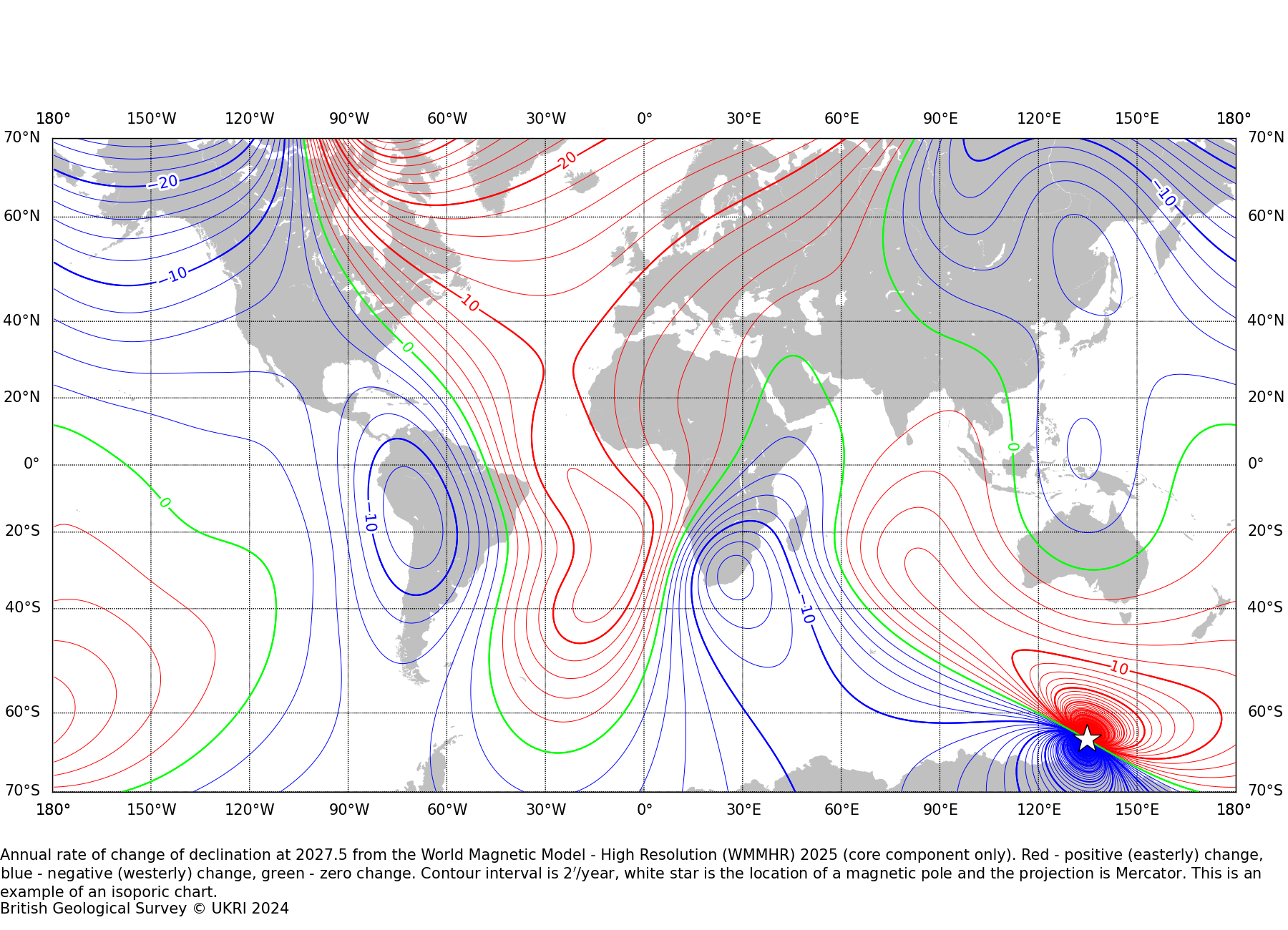World Magnetic Model (WMM)
The World Magnetic Model (WMM) is a standard model of the core and large-scale crustal magnetic field. It is used extensively for navigation and in attitude and heading referencing systems by the UK Ministry of Defence, the US Department of Defense, the North Atlantic Treaty Organization and the International Hydrographic Organization. It is also used widely in civilian navigation and heading systems.
New World Magnetic Model - High Resolution (WMMHR)
The latest WMM release consists of two models for the first time: World Magnetic Model 2025 (WMM2025), and World Magnetic Model - High Resolution 2025 (WMMHR2025). WMM2025 is degree 12 spherical harmonic model of the Earth’s main field (MF) at 2025.0, and a mean rate of change estimate (called secular variation, SV) over the period 2025.0 to 2030.0. WMMHR2025 covers the same time period, but with increased spatial resolution, providing greater accuracy for advanced users. WMMHR2025 extends the time varying main field component to spherical harmonic degree 15, and includes a crustal magnetic field model to spherical harmonic degree 133. Both models were produced collaboratively by combining models of the magnetic field derived by BGS and NOAA-NCEI. The 2025 technical report describing this will be published soon.
Irregular changes in the Earth’s core field limit the lifetime of any predictive model such as the WMM. The current version (WMM2025) was released in December 2024, and is valid for the period 2025.0 to 2030.0. The model was produced by BGS jointly with the US National Oceanic and Atmospheric Administration's National Centers for Environmental Information (NOAA/NCEI), with funding from the Defence Geographic Centre in the UK and the US National Geospatial-Intelligence Agency.
From 2021 onward the performance of the WMM is reviewed in a "State of the Geomagnetic Field" report, at the end of each year. Due to the release of a new generation of WMM in December 2024, the next annual performance report will be at the end of 2025.
In order to construct the BGS contributions to WMM we used data with as much coverage in space and time as possible. We took data from the three European Space Agency Swarm magnetic survey satellites (launched in November 2013) and from around 160 land-based observatories, up to October 2024. With these measurements, we constructed a complex model of the various sources of Earth's magnetic field and its time variations.
The WMM is a model of the core and large-scale crustal fields only. However the measured data contain unwanted signals from sources such as small-scale crustal, external ionospheric and magnetospheric fields and their induced counterparts. These fields would have added noise to the WMM model and could have biased its estimates.
BGS employed two techniques to avoid the contamination caused by external magnetic fields. Firstly we rejected those data most contaminated by these sources, as identified by a combination of local time, geomagnetic indices and solar wind data. However, this has an unwanted side effect in leaving temporal gaps in the data. This would have had a strong effect on the quality of the SV estimates. We lessened this effect by including similarly selected data from the magnetic ground observatories.
Our second technique was to initially model the larger unwanted sources that we could not easily reject, such as quiet time magnetosphere. We therefore constructed what we called a ‘parent model’ for the WMM, including these extra sources, before removing the unwanted components to finalise the WMM. Our colleagues at NOAA-NCEI follow their own procedure of calculations to produce their own ‘parent model’, and we then validate each others' models, and combine the results to produce the final WMM.

- Global Geomagnetic Models
- Space Weather and Geomagnetic Hazard
- High-frequency magnetometers
- Schumann Resonances
- Geoelectric field monitoring
- Space Weather Impact on Ground-based Systems (SWIGS)
- SWIMMR Activities in Ground Effects (SAGE)
- Geomagnetic Virtual Observatories
- Quantum magnetometers for space weather
- Magnetotellurics
- Publications List
- Release of World Magnetic Model (WMM) 2025 (2024)
- Magnetic north pole moving in way never seen before by scientists (2024)
- Podcast - Guardian's science weekly "Where on earth is North?" (2019)
- BGS blog - Updating the World Magnetic Model: From the centre of the Earth, straight to your pocket (2019)
- Nature - 'Earth's magnetic field is acting up and geologists don't know why' (2019)

